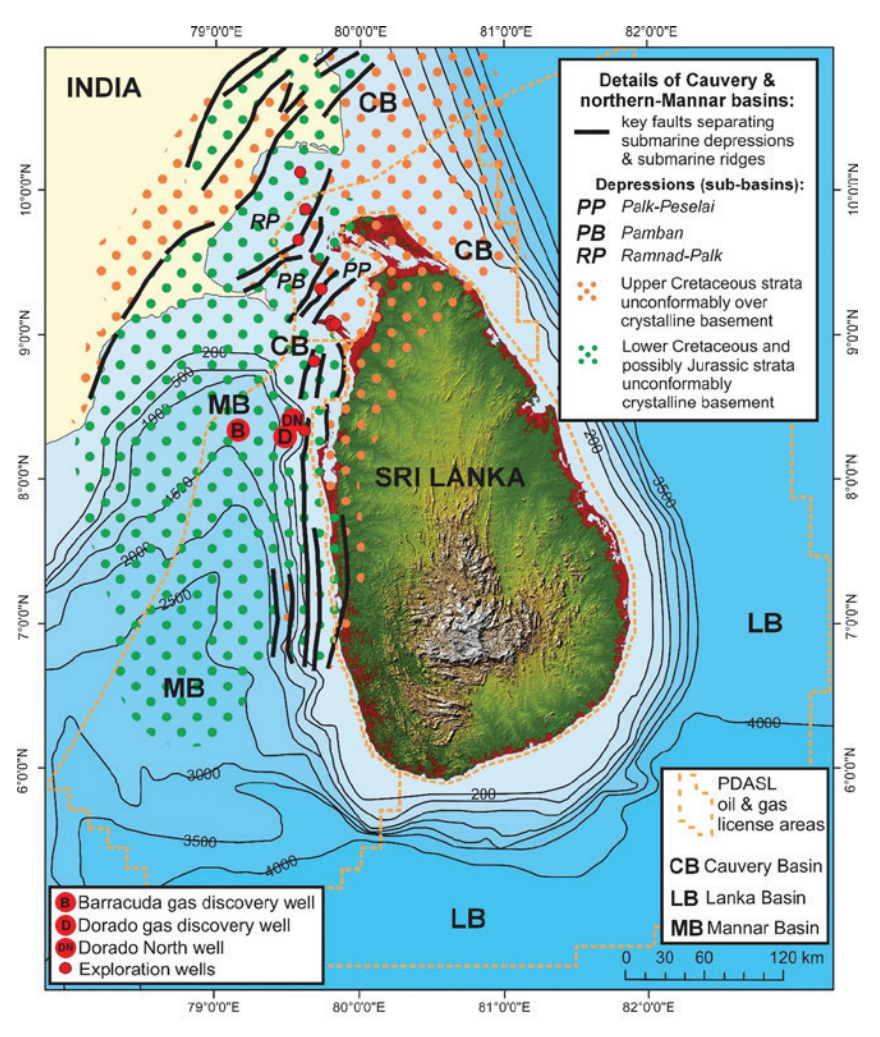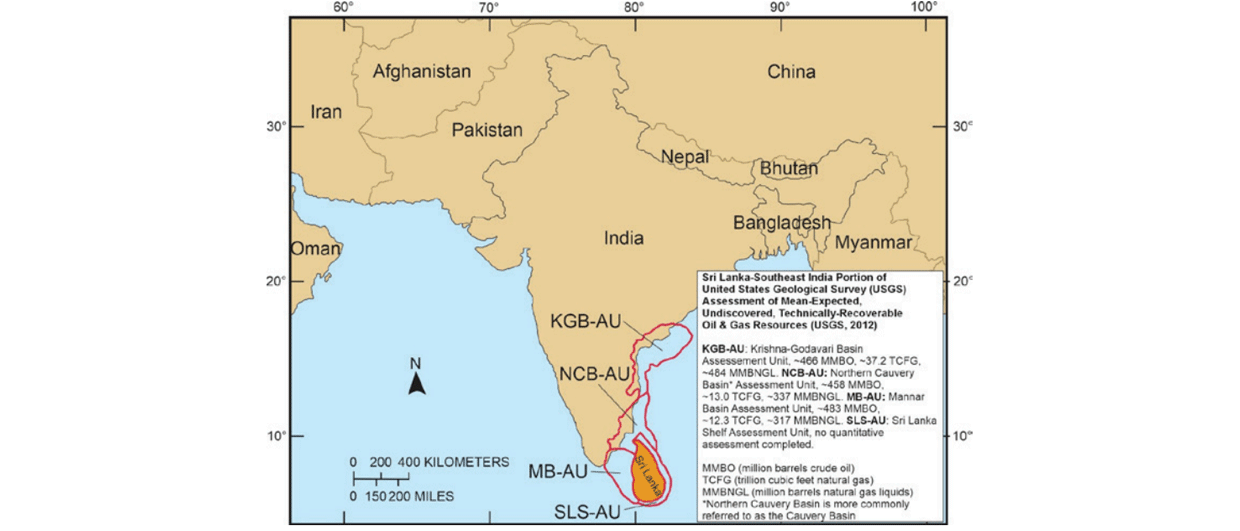Sri Lanka is enduring the worst economic crisis since its independence in 1948. Its economy has been on a general downward trend since 2018, shrank by nearly 8 % in 2022 – 2023, and only posted growth in the Final quarter of 2023.
At present, there is no in-country natural gas production or significant use and plans to build LNG storage and regasification facilities have stalled. Apart from hydroelectric, the country imports most of the energy it consumes, and imported oil and coal provide ~80 % of its power generation and transportation.
Geological research, exploration data, plus a 2012 USGS resource assessment indicate the offshore basins have significant petroleum potential with prospective plays lacking a single test well. Development of the discovered gas fields and returning exploration to the offshore offer Sri Lanka benefits: Alleviate its economic crisis, provide secure and inexpensive energy over decades and protect its independence in the geo-strategically important Indo-Pacific.
Here, we describe the potential of undiscovered, hydrocarbon resources in Sri Lanka’s portion of the Cauvery and Mannar basins and the potential of the Lanka Basin.
Onshore, Sri Lanka consists mostly of high-grade metamorphic rocks with no obvious oil and gas potential. However, the country has three offshore sedimentary basins: Mannar, Cauvery, and Lanka (Figure 1). In 2012, the USGS published a geologically based assessment of undiscovered, technically recoverable, conventional petroleum resources that included the Cauvery and Mannar basins – the Lanka Basin was not assessed due to lack of geologic data.
Cauvery Basin
Sri Lanka’s portion of the Cauvery Basin remains underexplored with only seven, non-commercial test wells in a narrow, north-south-band along the northwest offshore. The PH-9-1 well, located in the Indian portion of the Ramnad-Palk depression (sub-basin) of the Cauvery Basin tested 1,488 BOPD and 570 MCFPD natural gas from a Cretaceous clastic reservoir.
India’s portion of the Cauvery Basin is more explored than Sri Lanka’s portion and India has production from a Cretaceous age source-reservoir rock petroleum-system couplet. It is likely that this couplet extends into the Sri Lankan waters based on proximity, mapping of depressions, and modeling and analyses of well data. Understanding the petroleum system of the Sri Lankan portion of the basin is constrained by the small number and older age of test wells, limited sampling, and other key data such as biomarker analyses of hydrocarbon shows.
Mannar Basin
The Sri Lankan portion of the Mannar Basin has proven petroleum resources but remains undeveloped and underexplored, with only five wells, all in the northern portion of the basin. The basin’s undeveloped natural gas fields prove a productive petroleum system is present, and the basin’s geology suggests additional systems. The stratigraphic and structural traps in the late Jurassic through Eocene section, in the central part of the basin have excellent conditions for hydrocarbon accumulations.
Analyses of Barracuda, Dorado, and Dorado North well samples con- firm that the upper Cretaceous shale is a good to fair source rock (average TOCs are 1.37 % in Barracuda; 1.39 % in Dorado, and 1.64 % in Dorado North. An excellent Early Cretaceous source rock is likely present in the central part of the Mannar Basin given the basin’s subsidence history, recognition of a major global anoxic event in the adjacent Cauvery Basin, but there are no well penetrations below the Upper Cretaceous in the Mannar Basin.
Lanka Basin
The Lanka Basin is a frontier basin, lacking a single exploration well and source-rock analysis. However, the basin’s oil and gas potential is promising based on its regional setting along the eastern passive margin of the Indian Ocean. North of the Lanka Basin, numerous offshore oil seeps have been mapped using synthetic aperture radar data, including four seeps in the adjacent Cauvery Basin.
The regional tectonic history of the continental margin suggests the Lanka Basin should have extensional traps formed in the Late Jurassic to Early Cretaceous, quickly followed by the development of transpressional traps due to the basin’s position on the leeward side of the rotational-opening of the Mannar Basin and subsequent rifting of the Cauvery Basin during the Cretaceous. Recurring faulting during the Neogene, from collision of the Indian plate with Eurasia, steepened the Lankan Basin continental slope, and probably formed additional transpressional and convergent traps in the thick, deepwater prism.

Commercial quantities of natural gas in offshore Sri Lanka
In 2011, Cairn Lanka Private Limited’s Dorado well made the first discovery of natural gas in Sri Lanka, followed by the Barracuda natural gas discovery, and proving a productive petroleum system in the Upper Cretaceous section of the northern Mannar Basin. The discoveries are estimated to have a combined midcase recoverable of 839 BCF of gas and 5.88 MMB of condensate. Cairn departed the undeveloped fields in 2015 stating that the fields would not be commercial, a decision made when the average international oil prices were below $40 USD.
Opportunity, challenges, and pathway
The two undeveloped gas fields (Barracuda and Dorado) prove there is a productive petroleum system involving the upper Cretaceous source rocks of the Sri Lankan portion of the Mannar Basin. In addition, in-depth geologic and geochemical studies of the Mannar and Cauvery basins show there are additional potential petroleum systems but are yet to be proven productive. Amongst energy experts, it is broadly recognized that the present-day, worldwide, underinvestment in oil and gas exploration will constrain future supplies and become a threat to economic global growth. Avoiding this will require far more than the present levels of investment despite claims that renewable energy will suffice for the energy transition. Sri Lanka will be no exception.

